Business Analysis Report: Parramatta City Council Car Park Case Study
VerifiedAdded on 2023/06/07
|9
|2184
|420
Report
AI Summary
This report presents a business analysis of the Parramatta City Council car park system, examining its operational dynamics, customer service, and management processes. The analysis identifies key issues such as the allocation of parking spaces, payment discrepancies, and security concerns within the car parks. The report critically evaluates these issues, highlighting the advantages and disadvantages of the current system, including the use of seasonal tickets, sensor detection, and payment methods. Recommendations are provided to enhance security, improve customer satisfaction, and streamline operations, such as implementing fault recording systems, improving season ticket management, and enhancing security measures. The conclusion summarizes the findings and emphasizes the need for continuous improvement to maintain efficiency and customer trust within the car park system.

Running head: BUSINESS ANALYSIS
Case study analysis
Name of the student:
Name of the university:
Author note:
Case study analysis
Name of the student:
Name of the university:
Author note:
Paraphrase This Document
Need a fresh take? Get an instant paraphrase of this document with our AI Paraphraser
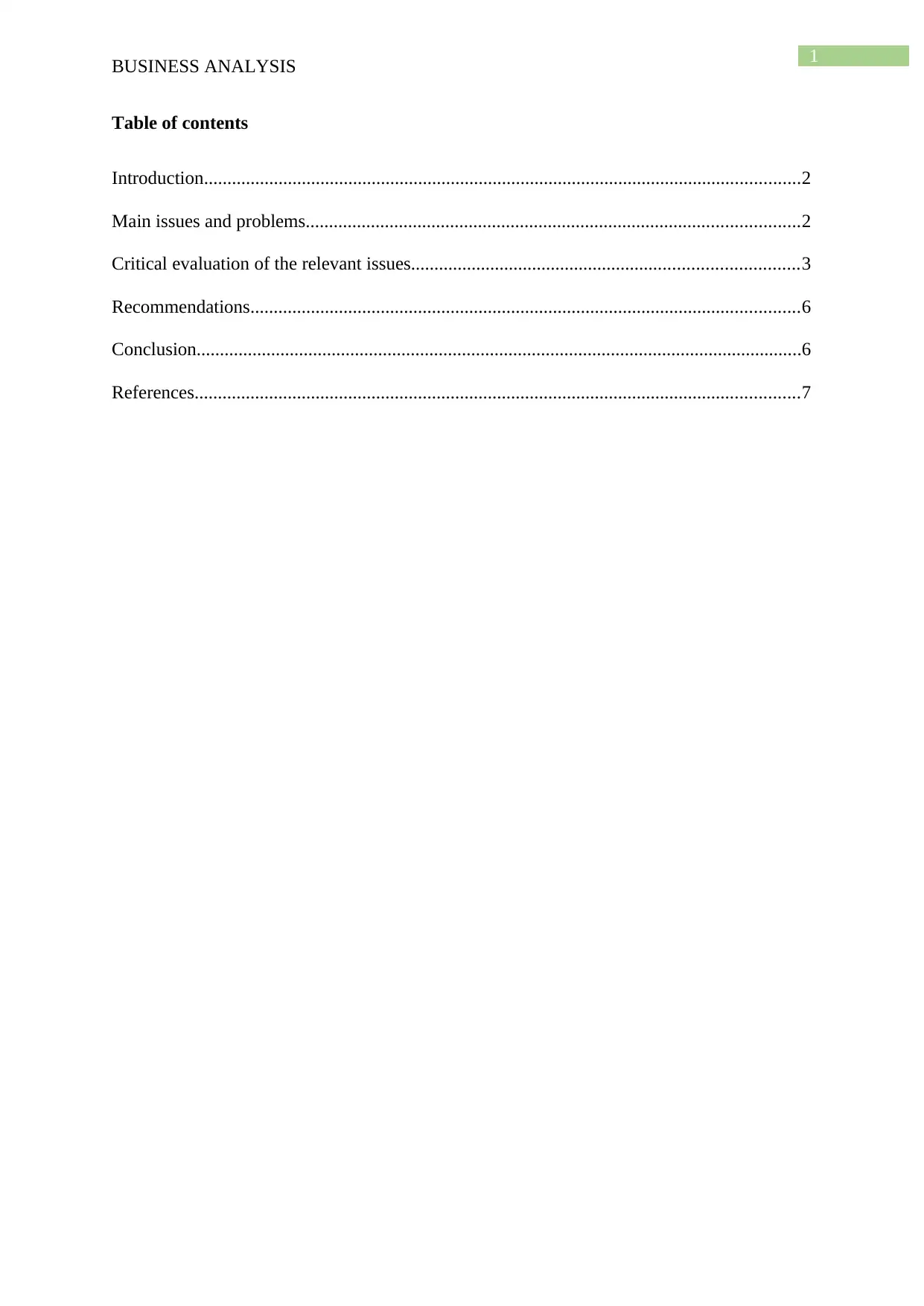
1
BUSINESS ANALYSIS
Table of contents
Introduction................................................................................................................................2
Main issues and problems..........................................................................................................2
Critical evaluation of the relevant issues...................................................................................3
Recommendations......................................................................................................................6
Conclusion..................................................................................................................................6
References..................................................................................................................................7
BUSINESS ANALYSIS
Table of contents
Introduction................................................................................................................................2
Main issues and problems..........................................................................................................2
Critical evaluation of the relevant issues...................................................................................3
Recommendations......................................................................................................................6
Conclusion..................................................................................................................................6
References..................................................................................................................................7
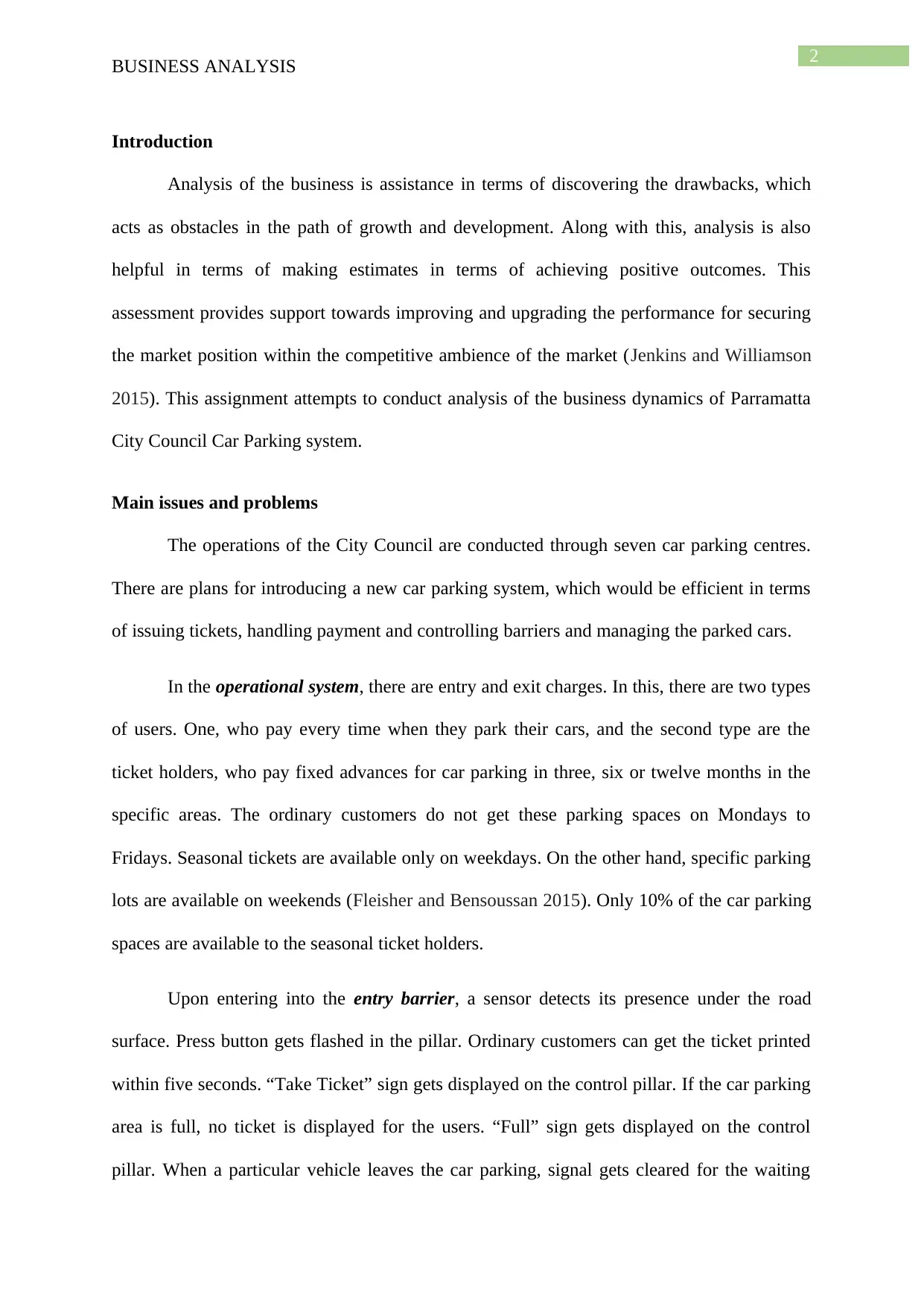
2
BUSINESS ANALYSIS
Introduction
Analysis of the business is assistance in terms of discovering the drawbacks, which
acts as obstacles in the path of growth and development. Along with this, analysis is also
helpful in terms of making estimates in terms of achieving positive outcomes. This
assessment provides support towards improving and upgrading the performance for securing
the market position within the competitive ambience of the market (Jenkins and Williamson
2015). This assignment attempts to conduct analysis of the business dynamics of Parramatta
City Council Car Parking system.
Main issues and problems
The operations of the City Council are conducted through seven car parking centres.
There are plans for introducing a new car parking system, which would be efficient in terms
of issuing tickets, handling payment and controlling barriers and managing the parked cars.
In the operational system, there are entry and exit charges. In this, there are two types
of users. One, who pay every time when they park their cars, and the second type are the
ticket holders, who pay fixed advances for car parking in three, six or twelve months in the
specific areas. The ordinary customers do not get these parking spaces on Mondays to
Fridays. Seasonal tickets are available only on weekdays. On the other hand, specific parking
lots are available on weekends (Fleisher and Bensoussan 2015). Only 10% of the car parking
spaces are available to the seasonal ticket holders.
Upon entering into the entry barrier, a sensor detects its presence under the road
surface. Press button gets flashed in the pillar. Ordinary customers can get the ticket printed
within five seconds. “Take Ticket” sign gets displayed on the control pillar. If the car parking
area is full, no ticket is displayed for the users. “Full” sign gets displayed on the control
pillar. When a particular vehicle leaves the car parking, signal gets cleared for the waiting
BUSINESS ANALYSIS
Introduction
Analysis of the business is assistance in terms of discovering the drawbacks, which
acts as obstacles in the path of growth and development. Along with this, analysis is also
helpful in terms of making estimates in terms of achieving positive outcomes. This
assessment provides support towards improving and upgrading the performance for securing
the market position within the competitive ambience of the market (Jenkins and Williamson
2015). This assignment attempts to conduct analysis of the business dynamics of Parramatta
City Council Car Parking system.
Main issues and problems
The operations of the City Council are conducted through seven car parking centres.
There are plans for introducing a new car parking system, which would be efficient in terms
of issuing tickets, handling payment and controlling barriers and managing the parked cars.
In the operational system, there are entry and exit charges. In this, there are two types
of users. One, who pay every time when they park their cars, and the second type are the
ticket holders, who pay fixed advances for car parking in three, six or twelve months in the
specific areas. The ordinary customers do not get these parking spaces on Mondays to
Fridays. Seasonal tickets are available only on weekdays. On the other hand, specific parking
lots are available on weekends (Fleisher and Bensoussan 2015). Only 10% of the car parking
spaces are available to the seasonal ticket holders.
Upon entering into the entry barrier, a sensor detects its presence under the road
surface. Press button gets flashed in the pillar. Ordinary customers can get the ticket printed
within five seconds. “Take Ticket” sign gets displayed on the control pillar. If the car parking
area is full, no ticket is displayed for the users. “Full” sign gets displayed on the control
pillar. When a particular vehicle leaves the car parking, signal gets cleared for the waiting
⊘ This is a preview!⊘
Do you want full access?
Subscribe today to unlock all pages.

Trusted by 1+ million students worldwide
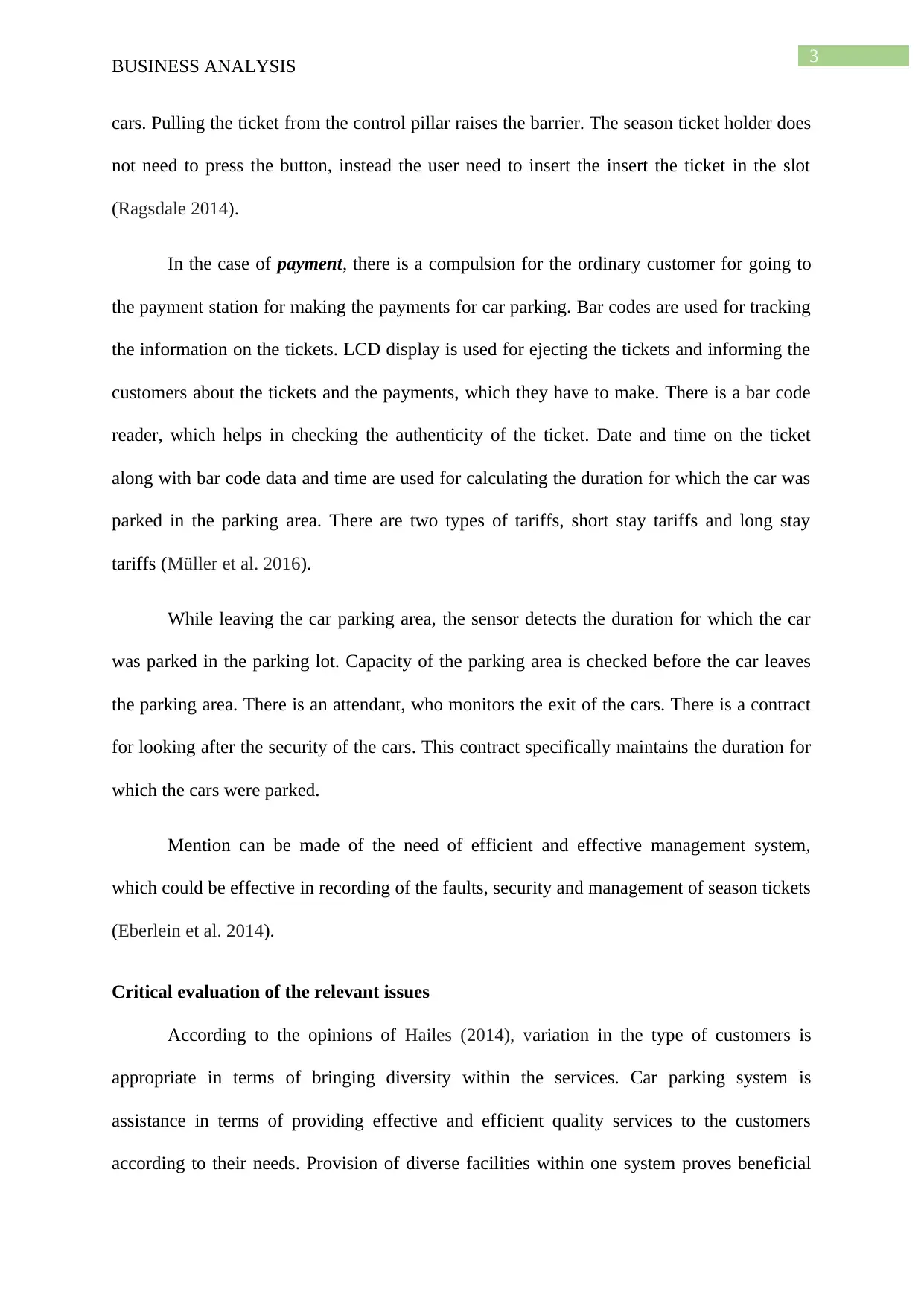
3
BUSINESS ANALYSIS
cars. Pulling the ticket from the control pillar raises the barrier. The season ticket holder does
not need to press the button, instead the user need to insert the insert the ticket in the slot
(Ragsdale 2014).
In the case of payment, there is a compulsion for the ordinary customer for going to
the payment station for making the payments for car parking. Bar codes are used for tracking
the information on the tickets. LCD display is used for ejecting the tickets and informing the
customers about the tickets and the payments, which they have to make. There is a bar code
reader, which helps in checking the authenticity of the ticket. Date and time on the ticket
along with bar code data and time are used for calculating the duration for which the car was
parked in the parking area. There are two types of tariffs, short stay tariffs and long stay
tariffs (Müller et al. 2016).
While leaving the car parking area, the sensor detects the duration for which the car
was parked in the parking lot. Capacity of the parking area is checked before the car leaves
the parking area. There is an attendant, who monitors the exit of the cars. There is a contract
for looking after the security of the cars. This contract specifically maintains the duration for
which the cars were parked.
Mention can be made of the need of efficient and effective management system,
which could be effective in recording of the faults, security and management of season tickets
(Eberlein et al. 2014).
Critical evaluation of the relevant issues
According to the opinions of Hailes (2014), variation in the type of customers is
appropriate in terms of bringing diversity within the services. Car parking system is
assistance in terms of providing effective and efficient quality services to the customers
according to their needs. Provision of diverse facilities within one system proves beneficial
BUSINESS ANALYSIS
cars. Pulling the ticket from the control pillar raises the barrier. The season ticket holder does
not need to press the button, instead the user need to insert the insert the ticket in the slot
(Ragsdale 2014).
In the case of payment, there is a compulsion for the ordinary customer for going to
the payment station for making the payments for car parking. Bar codes are used for tracking
the information on the tickets. LCD display is used for ejecting the tickets and informing the
customers about the tickets and the payments, which they have to make. There is a bar code
reader, which helps in checking the authenticity of the ticket. Date and time on the ticket
along with bar code data and time are used for calculating the duration for which the car was
parked in the parking area. There are two types of tariffs, short stay tariffs and long stay
tariffs (Müller et al. 2016).
While leaving the car parking area, the sensor detects the duration for which the car
was parked in the parking lot. Capacity of the parking area is checked before the car leaves
the parking area. There is an attendant, who monitors the exit of the cars. There is a contract
for looking after the security of the cars. This contract specifically maintains the duration for
which the cars were parked.
Mention can be made of the need of efficient and effective management system,
which could be effective in recording of the faults, security and management of season tickets
(Eberlein et al. 2014).
Critical evaluation of the relevant issues
According to the opinions of Hailes (2014), variation in the type of customers is
appropriate in terms of bringing diversity within the services. Car parking system is
assistance in terms of providing effective and efficient quality services to the customers
according to their needs. Provision of diverse facilities within one system proves beneficial
Paraphrase This Document
Need a fresh take? Get an instant paraphrase of this document with our AI Paraphraser
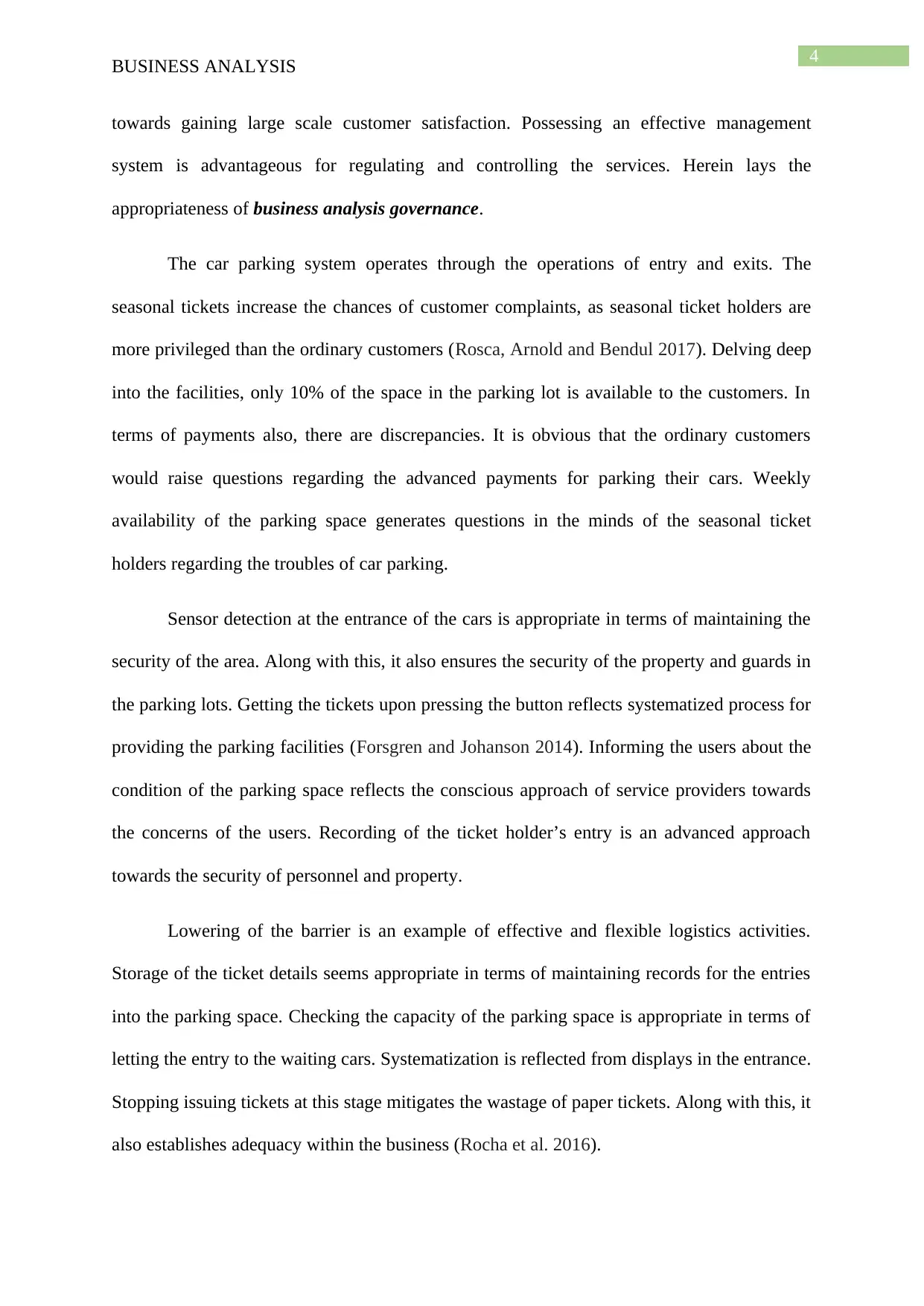
4
BUSINESS ANALYSIS
towards gaining large scale customer satisfaction. Possessing an effective management
system is advantageous for regulating and controlling the services. Herein lays the
appropriateness of business analysis governance.
The car parking system operates through the operations of entry and exits. The
seasonal tickets increase the chances of customer complaints, as seasonal ticket holders are
more privileged than the ordinary customers (Rosca, Arnold and Bendul 2017). Delving deep
into the facilities, only 10% of the space in the parking lot is available to the customers. In
terms of payments also, there are discrepancies. It is obvious that the ordinary customers
would raise questions regarding the advanced payments for parking their cars. Weekly
availability of the parking space generates questions in the minds of the seasonal ticket
holders regarding the troubles of car parking.
Sensor detection at the entrance of the cars is appropriate in terms of maintaining the
security of the area. Along with this, it also ensures the security of the property and guards in
the parking lots. Getting the tickets upon pressing the button reflects systematized process for
providing the parking facilities (Forsgren and Johanson 2014). Informing the users about the
condition of the parking space reflects the conscious approach of service providers towards
the concerns of the users. Recording of the ticket holder’s entry is an advanced approach
towards the security of personnel and property.
Lowering of the barrier is an example of effective and flexible logistics activities.
Storage of the ticket details seems appropriate in terms of maintaining records for the entries
into the parking space. Checking the capacity of the parking space is appropriate in terms of
letting the entry to the waiting cars. Systematization is reflected from displays in the entrance.
Stopping issuing tickets at this stage mitigates the wastage of paper tickets. Along with this, it
also establishes adequacy within the business (Rocha et al. 2016).
BUSINESS ANALYSIS
towards gaining large scale customer satisfaction. Possessing an effective management
system is advantageous for regulating and controlling the services. Herein lays the
appropriateness of business analysis governance.
The car parking system operates through the operations of entry and exits. The
seasonal tickets increase the chances of customer complaints, as seasonal ticket holders are
more privileged than the ordinary customers (Rosca, Arnold and Bendul 2017). Delving deep
into the facilities, only 10% of the space in the parking lot is available to the customers. In
terms of payments also, there are discrepancies. It is obvious that the ordinary customers
would raise questions regarding the advanced payments for parking their cars. Weekly
availability of the parking space generates questions in the minds of the seasonal ticket
holders regarding the troubles of car parking.
Sensor detection at the entrance of the cars is appropriate in terms of maintaining the
security of the area. Along with this, it also ensures the security of the property and guards in
the parking lots. Getting the tickets upon pressing the button reflects systematized process for
providing the parking facilities (Forsgren and Johanson 2014). Informing the users about the
condition of the parking space reflects the conscious approach of service providers towards
the concerns of the users. Recording of the ticket holder’s entry is an advanced approach
towards the security of personnel and property.
Lowering of the barrier is an example of effective and flexible logistics activities.
Storage of the ticket details seems appropriate in terms of maintaining records for the entries
into the parking space. Checking the capacity of the parking space is appropriate in terms of
letting the entry to the waiting cars. Systematization is reflected from displays in the entrance.
Stopping issuing tickets at this stage mitigates the wastage of paper tickets. Along with this, it
also establishes adequacy within the business (Rocha et al. 2016).
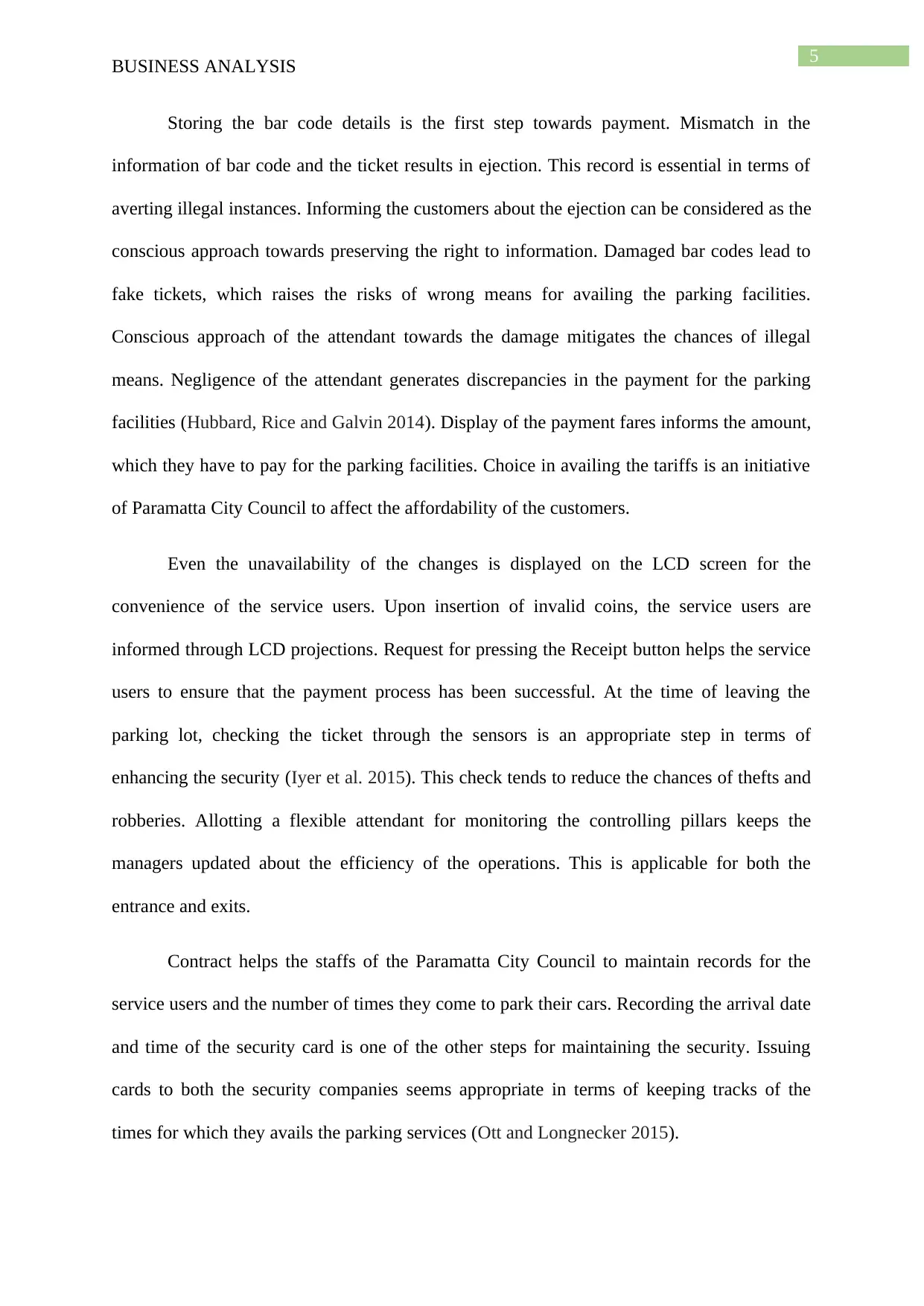
5
BUSINESS ANALYSIS
Storing the bar code details is the first step towards payment. Mismatch in the
information of bar code and the ticket results in ejection. This record is essential in terms of
averting illegal instances. Informing the customers about the ejection can be considered as the
conscious approach towards preserving the right to information. Damaged bar codes lead to
fake tickets, which raises the risks of wrong means for availing the parking facilities.
Conscious approach of the attendant towards the damage mitigates the chances of illegal
means. Negligence of the attendant generates discrepancies in the payment for the parking
facilities (Hubbard, Rice and Galvin 2014). Display of the payment fares informs the amount,
which they have to pay for the parking facilities. Choice in availing the tariffs is an initiative
of Paramatta City Council to affect the affordability of the customers.
Even the unavailability of the changes is displayed on the LCD screen for the
convenience of the service users. Upon insertion of invalid coins, the service users are
informed through LCD projections. Request for pressing the Receipt button helps the service
users to ensure that the payment process has been successful. At the time of leaving the
parking lot, checking the ticket through the sensors is an appropriate step in terms of
enhancing the security (Iyer et al. 2015). This check tends to reduce the chances of thefts and
robberies. Allotting a flexible attendant for monitoring the controlling pillars keeps the
managers updated about the efficiency of the operations. This is applicable for both the
entrance and exits.
Contract helps the staffs of the Paramatta City Council to maintain records for the
service users and the number of times they come to park their cars. Recording the arrival date
and time of the security card is one of the other steps for maintaining the security. Issuing
cards to both the security companies seems appropriate in terms of keeping tracks of the
times for which they avails the parking services (Ott and Longnecker 2015).
BUSINESS ANALYSIS
Storing the bar code details is the first step towards payment. Mismatch in the
information of bar code and the ticket results in ejection. This record is essential in terms of
averting illegal instances. Informing the customers about the ejection can be considered as the
conscious approach towards preserving the right to information. Damaged bar codes lead to
fake tickets, which raises the risks of wrong means for availing the parking facilities.
Conscious approach of the attendant towards the damage mitigates the chances of illegal
means. Negligence of the attendant generates discrepancies in the payment for the parking
facilities (Hubbard, Rice and Galvin 2014). Display of the payment fares informs the amount,
which they have to pay for the parking facilities. Choice in availing the tariffs is an initiative
of Paramatta City Council to affect the affordability of the customers.
Even the unavailability of the changes is displayed on the LCD screen for the
convenience of the service users. Upon insertion of invalid coins, the service users are
informed through LCD projections. Request for pressing the Receipt button helps the service
users to ensure that the payment process has been successful. At the time of leaving the
parking lot, checking the ticket through the sensors is an appropriate step in terms of
enhancing the security (Iyer et al. 2015). This check tends to reduce the chances of thefts and
robberies. Allotting a flexible attendant for monitoring the controlling pillars keeps the
managers updated about the efficiency of the operations. This is applicable for both the
entrance and exits.
Contract helps the staffs of the Paramatta City Council to maintain records for the
service users and the number of times they come to park their cars. Recording the arrival date
and time of the security card is one of the other steps for maintaining the security. Issuing
cards to both the security companies seems appropriate in terms of keeping tracks of the
times for which they avails the parking services (Ott and Longnecker 2015).
⊘ This is a preview!⊘
Do you want full access?
Subscribe today to unlock all pages.

Trusted by 1+ million students worldwide
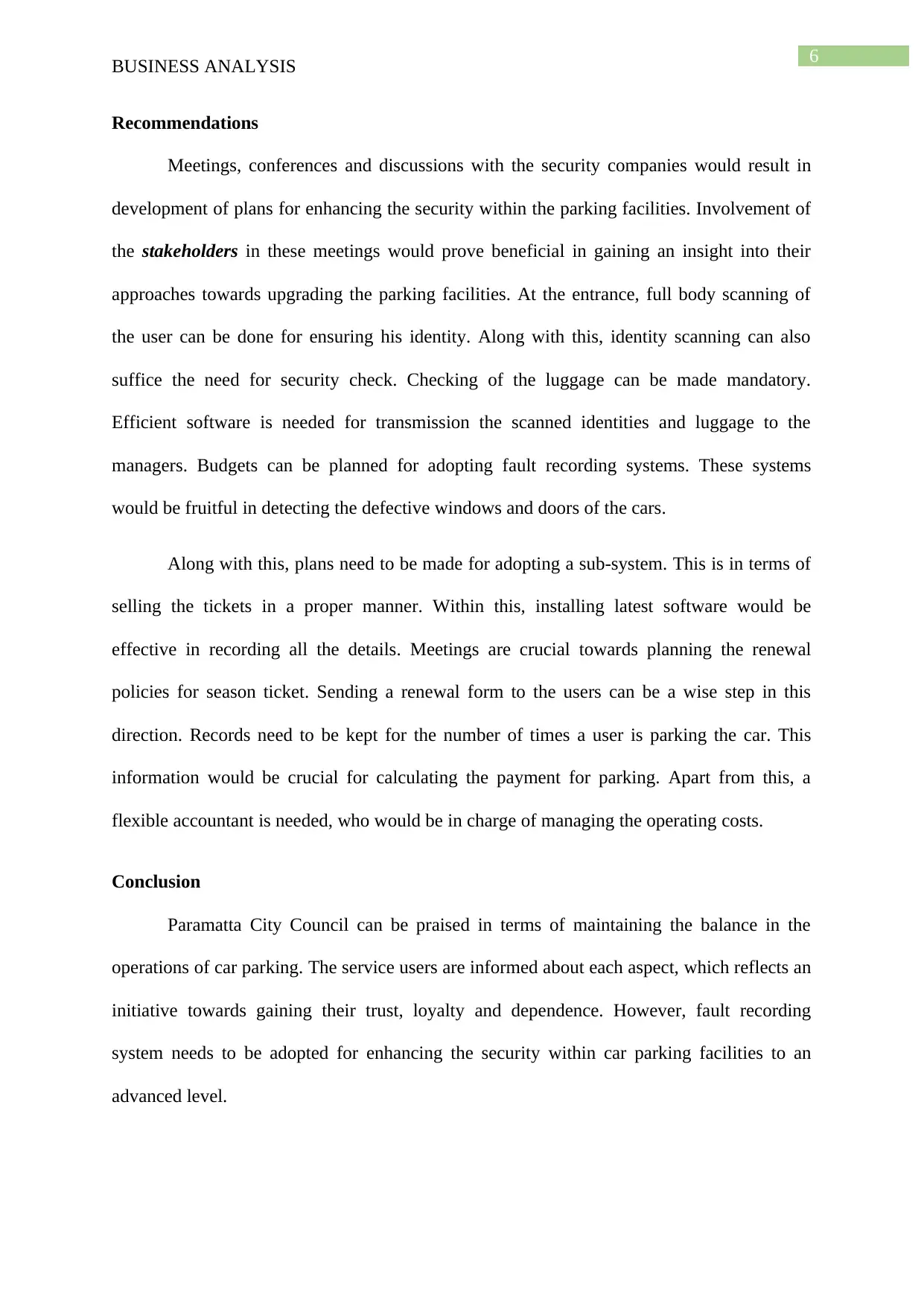
6
BUSINESS ANALYSIS
Recommendations
Meetings, conferences and discussions with the security companies would result in
development of plans for enhancing the security within the parking facilities. Involvement of
the stakeholders in these meetings would prove beneficial in gaining an insight into their
approaches towards upgrading the parking facilities. At the entrance, full body scanning of
the user can be done for ensuring his identity. Along with this, identity scanning can also
suffice the need for security check. Checking of the luggage can be made mandatory.
Efficient software is needed for transmission the scanned identities and luggage to the
managers. Budgets can be planned for adopting fault recording systems. These systems
would be fruitful in detecting the defective windows and doors of the cars.
Along with this, plans need to be made for adopting a sub-system. This is in terms of
selling the tickets in a proper manner. Within this, installing latest software would be
effective in recording all the details. Meetings are crucial towards planning the renewal
policies for season ticket. Sending a renewal form to the users can be a wise step in this
direction. Records need to be kept for the number of times a user is parking the car. This
information would be crucial for calculating the payment for parking. Apart from this, a
flexible accountant is needed, who would be in charge of managing the operating costs.
Conclusion
Paramatta City Council can be praised in terms of maintaining the balance in the
operations of car parking. The service users are informed about each aspect, which reflects an
initiative towards gaining their trust, loyalty and dependence. However, fault recording
system needs to be adopted for enhancing the security within car parking facilities to an
advanced level.
BUSINESS ANALYSIS
Recommendations
Meetings, conferences and discussions with the security companies would result in
development of plans for enhancing the security within the parking facilities. Involvement of
the stakeholders in these meetings would prove beneficial in gaining an insight into their
approaches towards upgrading the parking facilities. At the entrance, full body scanning of
the user can be done for ensuring his identity. Along with this, identity scanning can also
suffice the need for security check. Checking of the luggage can be made mandatory.
Efficient software is needed for transmission the scanned identities and luggage to the
managers. Budgets can be planned for adopting fault recording systems. These systems
would be fruitful in detecting the defective windows and doors of the cars.
Along with this, plans need to be made for adopting a sub-system. This is in terms of
selling the tickets in a proper manner. Within this, installing latest software would be
effective in recording all the details. Meetings are crucial towards planning the renewal
policies for season ticket. Sending a renewal form to the users can be a wise step in this
direction. Records need to be kept for the number of times a user is parking the car. This
information would be crucial for calculating the payment for parking. Apart from this, a
flexible accountant is needed, who would be in charge of managing the operating costs.
Conclusion
Paramatta City Council can be praised in terms of maintaining the balance in the
operations of car parking. The service users are informed about each aspect, which reflects an
initiative towards gaining their trust, loyalty and dependence. However, fault recording
system needs to be adopted for enhancing the security within car parking facilities to an
advanced level.
Paraphrase This Document
Need a fresh take? Get an instant paraphrase of this document with our AI Paraphraser
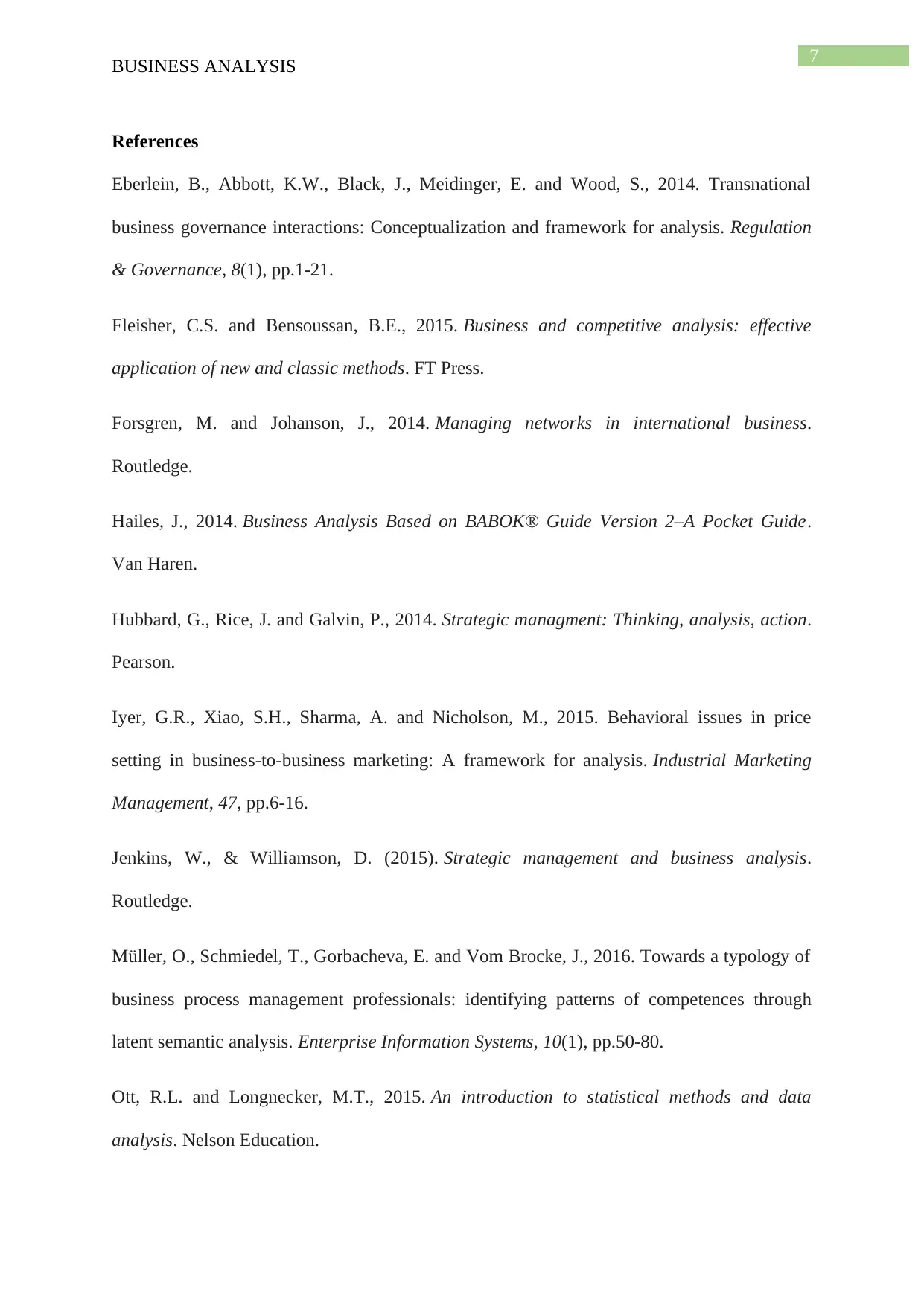
7
BUSINESS ANALYSIS
References
Eberlein, B., Abbott, K.W., Black, J., Meidinger, E. and Wood, S., 2014. Transnational
business governance interactions: Conceptualization and framework for analysis. Regulation
& Governance, 8(1), pp.1-21.
Fleisher, C.S. and Bensoussan, B.E., 2015. Business and competitive analysis: effective
application of new and classic methods. FT Press.
Forsgren, M. and Johanson, J., 2014. Managing networks in international business.
Routledge.
Hailes, J., 2014. Business Analysis Based on BABOK® Guide Version 2–A Pocket Guide.
Van Haren.
Hubbard, G., Rice, J. and Galvin, P., 2014. Strategic managment: Thinking, analysis, action.
Pearson.
Iyer, G.R., Xiao, S.H., Sharma, A. and Nicholson, M., 2015. Behavioral issues in price
setting in business-to-business marketing: A framework for analysis. Industrial Marketing
Management, 47, pp.6-16.
Jenkins, W., & Williamson, D. (2015). Strategic management and business analysis.
Routledge.
Müller, O., Schmiedel, T., Gorbacheva, E. and Vom Brocke, J., 2016. Towards a typology of
business process management professionals: identifying patterns of competences through
latent semantic analysis. Enterprise Information Systems, 10(1), pp.50-80.
Ott, R.L. and Longnecker, M.T., 2015. An introduction to statistical methods and data
analysis. Nelson Education.
BUSINESS ANALYSIS
References
Eberlein, B., Abbott, K.W., Black, J., Meidinger, E. and Wood, S., 2014. Transnational
business governance interactions: Conceptualization and framework for analysis. Regulation
& Governance, 8(1), pp.1-21.
Fleisher, C.S. and Bensoussan, B.E., 2015. Business and competitive analysis: effective
application of new and classic methods. FT Press.
Forsgren, M. and Johanson, J., 2014. Managing networks in international business.
Routledge.
Hailes, J., 2014. Business Analysis Based on BABOK® Guide Version 2–A Pocket Guide.
Van Haren.
Hubbard, G., Rice, J. and Galvin, P., 2014. Strategic managment: Thinking, analysis, action.
Pearson.
Iyer, G.R., Xiao, S.H., Sharma, A. and Nicholson, M., 2015. Behavioral issues in price
setting in business-to-business marketing: A framework for analysis. Industrial Marketing
Management, 47, pp.6-16.
Jenkins, W., & Williamson, D. (2015). Strategic management and business analysis.
Routledge.
Müller, O., Schmiedel, T., Gorbacheva, E. and Vom Brocke, J., 2016. Towards a typology of
business process management professionals: identifying patterns of competences through
latent semantic analysis. Enterprise Information Systems, 10(1), pp.50-80.
Ott, R.L. and Longnecker, M.T., 2015. An introduction to statistical methods and data
analysis. Nelson Education.
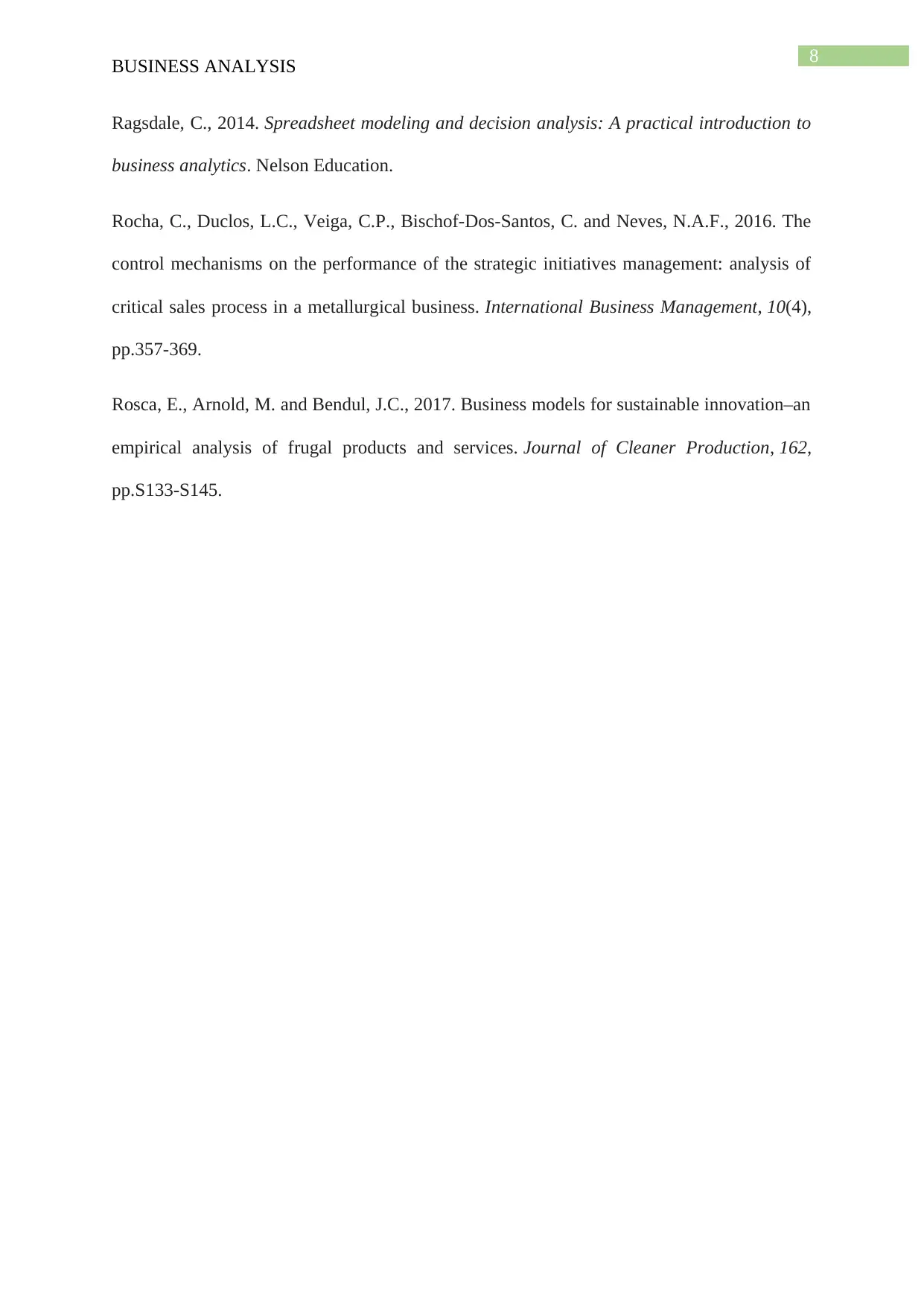
8
BUSINESS ANALYSIS
Ragsdale, C., 2014. Spreadsheet modeling and decision analysis: A practical introduction to
business analytics. Nelson Education.
Rocha, C., Duclos, L.C., Veiga, C.P., Bischof-Dos-Santos, C. and Neves, N.A.F., 2016. The
control mechanisms on the performance of the strategic initiatives management: analysis of
critical sales process in a metallurgical business. International Business Management, 10(4),
pp.357-369.
Rosca, E., Arnold, M. and Bendul, J.C., 2017. Business models for sustainable innovation–an
empirical analysis of frugal products and services. Journal of Cleaner Production, 162,
pp.S133-S145.
BUSINESS ANALYSIS
Ragsdale, C., 2014. Spreadsheet modeling and decision analysis: A practical introduction to
business analytics. Nelson Education.
Rocha, C., Duclos, L.C., Veiga, C.P., Bischof-Dos-Santos, C. and Neves, N.A.F., 2016. The
control mechanisms on the performance of the strategic initiatives management: analysis of
critical sales process in a metallurgical business. International Business Management, 10(4),
pp.357-369.
Rosca, E., Arnold, M. and Bendul, J.C., 2017. Business models for sustainable innovation–an
empirical analysis of frugal products and services. Journal of Cleaner Production, 162,
pp.S133-S145.
⊘ This is a preview!⊘
Do you want full access?
Subscribe today to unlock all pages.

Trusted by 1+ million students worldwide
1 out of 9
Related Documents
Your All-in-One AI-Powered Toolkit for Academic Success.
+13062052269
info@desklib.com
Available 24*7 on WhatsApp / Email
![[object Object]](/_next/static/media/star-bottom.7253800d.svg)
Unlock your academic potential
Copyright © 2020–2025 A2Z Services. All Rights Reserved. Developed and managed by ZUCOL.





